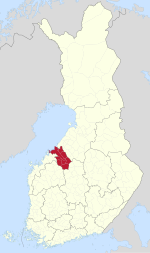Central Ostrobothnia
You can help expand this article with text translated from the corresponding article in Finnish. (June 2023) Click [show] for important translation instructions.
|
Central Ostrobothnia | |
|---|---|
| Region of Central Ostrobothnia Keski-Pohjanmaan maakunta Landskapet Mellersta Österbotten | |
 Central Ostrobothnia on a map of Finland | |
| Coordinates: 63°30′N 24°15′E / 63.500°N 24.250°E | |
| Country | Finland |
| Historical province | Ostrobothnia |
| Capital | Kokkola |
| Other town | Kannus |
| Area | |
| • Total | 6,463 km2 (2,495 sq mi) |
| Population (2023)[1] | |
| • Total | 67,736 |
| • Density | 13/km2 (30/sq mi) |
| GDP | |
| • Total | €2.425 billion (2015) |
| • Per capita | €35,181 (2015) |
| Time zone | UTC+2 (EET) |
| • Summer (DST) | UTC+3 (EEST) |
| ISO 3166 code | FI-07 |
| NUTS | 1A1 |
| Regional bird | Skylark (Alauda arvensis) |
| Regional fish | European whitefish (Coregonus lavaretus) |
| Regional flower | Bluebell (Harebell) |
| Regional stone | Gneiss |
| Regional lake | Lake Lestijärvi |
| Website | keski-pohjanmaa.fi |
Central Ostrobothnia (Finnish: Keski-Pohjanmaa; Swedish: Mellersta Österbotten) is a region in Finland. Central Ostrobothnia borders the Bothnian Bay and the regions of Ostrobothnia, North Ostrobothnia, Central Finland and South Ostrobothnia.[3] The regional bird of Central Ostrobothnia is the Eurasian skylark, the regional stone is Gneiss, the regional lake is Lake Lestijärvi, the regional fish is European whitefish. The capital and largest city of the region is Kokkola.
Central Ostrobothnia has an area of 6,462.93 km, of which 5,019.98 km² is land area.[4] Central Ostrobothnia, including the sea areas, is the smallest province in mainland Finland in terms of population and total area, and the second smallest province in Finland after Åland. However, if you count the land area alone, Kymenlaakso is smaller than Central Ostrobothnia.
Historical provinces
[edit]Municipalities
[edit]The region of Central Ostrobothnia consists of eight municipalities, two of which have city status (marked in bold).
Sub-regions
[edit]List of municipalities
[edit]| Coat of arms | Municipality | Population | Land area (km2) | Density (/km2) | Finnish speakers | Swedish speakers | Other speakers |
|---|---|---|---|---|---|---|---|
 | Halsua | 1,001 | 413 | 2 | 96 % | 0.5 % | 5 % |
 | Kannus | 5,251 | 468 | 11 | 97 % | 0.4 % | 3 % |
 | Kaustinen | 4,125 | 354 | 12 | 95 % | 1.8 % | 3 % |
 | Kokkola | 48,297 | 1,446 | 33 | 83 % | 12 % | 5 % |
 | Lestijärvi | 656 | 480 | 1 | 102 % | 0.2 % | 2 % |
 | Perho | 2,588 | 748 | 3 | 98 % | 0.5 % | 1 % |
 | Toholampi | 2,827 | 609 | 5 | 98 % | 0.1 % | 2 % |
 | Veteli | 2,933 | 502 | 6 | 95 % | 1.7 % | 3 % |
| Total | 67,678 | 5,020 | 13 | 87 % | 9 % | 4 % |
Politics
[edit]Results of the 2019 Finnish parliamentary election in Central Ostrobothnia:
- Centre Party 31.09%
- Finns Party 19.60%
- Social Democratic Party 16.06%
- National Coalition Party 7.42%
- Christian Democrats 7.29%
- Swedish People's Party 6.26%
- Green League 6.03%
- Left Alliance 4.11%
- Blue Reform 0.80%
- Seven Star Movement 0.36%
- Other parties 0.98%
References
[edit]- ^ https://pxdata.stat.fi/PxWeb/pxweb/en/StatFin/StatFin__vaerak/statfin_vaerak_pxt_11ra.px/
- ^ Regions and Cities > Regional Statistics > Regional Economy > Regional GDP per Capita, OECD.Stats. Accessed on 16 November 2018.
- ^ Nordberg, Kenneth (2016-11-23). Revolutionizing Economic and Democratic Systems: Reinventing the Third Way. Springer. pp. 70–71. ISBN 978-3-319-40633-6.
- ^ "8 Keski-Pohjanmaa" (PDF). 30 October 2024. Retrieved 30 October 2024.


 French
French Deutsch
Deutsch

